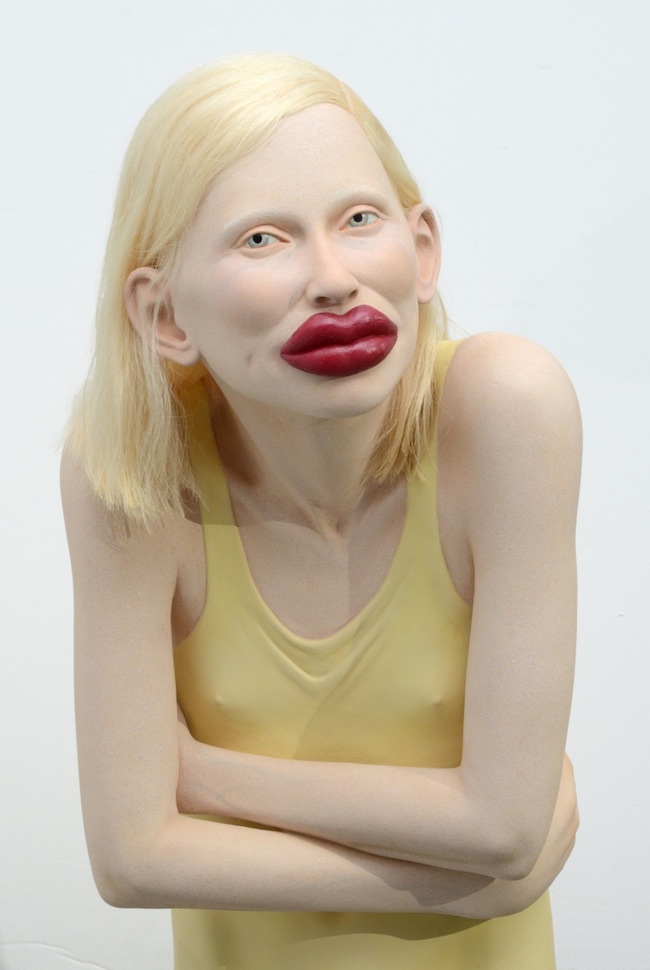The Museum of Arts and Design (MAD) presents Body & Soul: New International Ceramics through March 2, 2014. The exhibition features the work of 24 international ceramic artists, not all ceramists, which the museum claims addresses “critical social and political issues through figurative sculpture. By way of clay, the figure becomes a catalyst for exploring the impact of contemporary pressures confronting societies today.”
It is an exhibition with great charm but several flaws. Its claim to be “new” international ceramics is not delivered. There are “new” directions in the ceramic figure today but these are not visited. Cutting edge artists in the genre (including work in unfired clay) like Matt Wedel, Heather Cassils, Jeffrey Mitchell, Prune Nourry, Urs Fischer, and Adrián Villar Rojas are not included. Many of the participants are working in an aesthetic they established decades ago. The works by Akio Takamori and Tip Toland are exceptional but they are not new. And furthermore, the exhibition has a piecemeal feeling. It is international, but nominally so. I could be wrong, but suspect that it began as a survey of French art and then, step by step, a few works from Europe and the USA were added as an afterthought to justify the international label. It would have been stronger and had more cultural coherence speaking only in a Francophile voice.
Themes explored in the exhibition include gun violence, bullying, rebellion, sexual abuse, anxiety, and identity; as would any group contemporary sculpture survey. But no convincing reason is given for the ceramic theme. Guest Curator Wendy Tarlow Kaplan makes a stab, “The artist with a social conscience who models in clay strives to capture an immediacy and a passion through tactile manipulation.” But this is equally true of an artist who models in any plastic medium; plaster, unfired clay (the rising “new” medium), wax and any number of old and new plastic materials that are widely in use in sculpture today.
Few pieces felt as if ceramics was an essential material choice for their realization. They could have been made in alternative media without loosing their conceptual intent and, in a few cases, would have benefited from being in a non-ceramic material. Mostly, ceramics here is a material of convenience or default. For ceramics to play a central role in the sculptural aesthetic of an artwork it has to employ the qualities that are unique to the medium, from the fire to ceramic history, which lock the work into a dialog with the material. Myriam Mechita achieves this, albeit literally, with Sèvres plates cutting through a skull which unleashes a myriad of references including to the French Revolution. So do the works that are similarly tied to court porcelains—such as those by Chris Antemann (in collaboration with Kendrick Moholt) and Jessica Harrison—but this theme does not run throughout.
I enjoyed the diversity in the show and, again, it has a soft, romantic charm. Many of the artists are working more as illustrators than sculptors, which doesn’t mean that their works aren’t of interest. Visitors will leave with something pleasurable to take away but only if they set aside the expectations raised by the show’s title.
The exhibition is accompanied by a fully-illustrated 128-page color publication, featuring images of each of the works in the exhibition and full artist biographies, with essays by David Revere McFadden, the William and Mildred Lasdon Chief Curator of MAD; Wendy Tarlow Kaplan, Guest Curator; Laurent de Verneuil, Guest Curator; and additional essays on figurative ceramics, gender issues, and violence by leading scholars.
Garth Clark is the Chief Editor of CFile
Above image: Tip Toland, Grace Flirts, 2008.Stoneware, paint, pastel, hair, wax lips. Courtesy of Barry Friedman Ltd., New York. Photograph by Andrew Bovasso.

Valérie Delarue, Corps au Travail (Body of Work) Screenshot, 2010. Video. Photograph © 2013 Artists Rights Society (ARS), New York / ADAGP, Paris.

Marc Alberghina, Saint Sébastien A, 2011–12. Earthenware, enamel. 80 x 140 x 60 cm. Courtesy of the artist.

Michel Gouéry, Riri, 2006. Enameled terra-cotta. Courtesy of Galerie Anne de Villepoix, Paris. Photograph by the artist.

Anne Wenzel, Untitled (Black Girl), 2010. Ceramic. Courtesy of Leyla Akinci Galerie, Amsterdam and Gallerie Tatjana Pieters, Gent.

Myriam Mechita, L’infini en Plus (Infinity and More), 2010. Sèvres porcelain. Courtesy of the artist. Photograph by Gerard Jonca.

Mounir Fatmi, Forget, 2010. Porcelain. Courtesy of the artist and Goodman Gallery, Johannesburg, Cape Town. Photograph by Zarhloul for Studio Fatmi.

Chris Antemann in collaboration with Kendrick Moholt, Feast of Impropriety, 2011. Photograph. Archival paper, ink. Courtesy of the artists.

Jessica Harrison, Andrea, 2013. Found ceramic, epoxy resin putty, enamel paint. Courtesy of the artist.

Akio Takamori, Nymph and Satyr, 2011. Stoneware with underglazes. Courtesy of Barry Friedman Ltd., New York. Photograph by Vicky Takamori.

Tip Toland, Grace Flirts, 2008.Stoneware, paint, pastel, hair, wax lips. Courtesy of Barry Friedman Ltd., New York. Photograph by Andrew Bovasso.
Visit the Museum of Arts and Design

Add your valued opinion to this post.